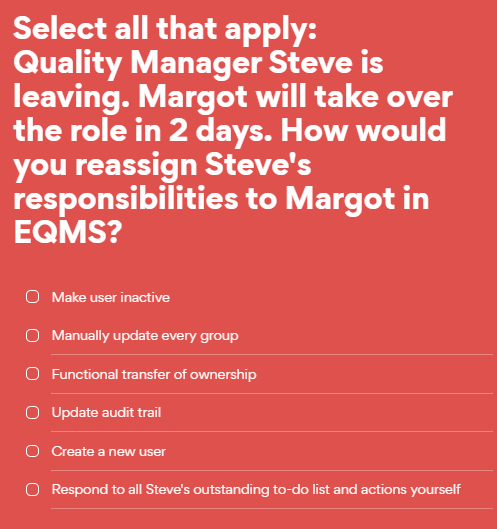Want to contribute to this article?
So your business - or at least, some people in it - has accepted the need for a new electronic quality management system. This might be to reduce wastage or variation, to help you expand healthily, or to hit a new accreditation standard.
Whatever the reason, you're at the start of the QMS vendor scoping process. That means weighing up pros and cons, planning your migration and implementation, and asking plenty of questions. But where do you begin?
We asked 3 of our customers how they navigated the process and what to look out for.

1. Let your requirements create a shortlist
I had twenty points I wanted to see. I started with ten vendors, reduced it to five, then ended up meeting three.
- Pauline Sourdille,
Quality, Training & Health/Safety Manager, Sirus
There are dozens of GRC and QMS software vendors on the market that might be suitable for your business. Meeting them all would be impossible (or very inconvenient).
When scoping a quality management system for her business, energy solutions provider Sirus, Quality Manager Pauline Sourdille drafted a list of twenty requirements, then let them create a shortlist for her.
By being restrictive and performing quick online assessments and tender assessments with potential vendors, Pauline eliminated 70% of her vendor list, leaving a much more manageable shortlist for further scoping and face-to-face discussion.
Consider things like:
- Do you want an on-premise or cloud-based solution? Or something that can offer both?
- Do you have specific linguistic requirements?
- How scalable does your solution need to be - and how does each vendor's pricing structure support that?
- Do you need a mobile solution for greater integration, or purely desktop-based?
The more requirements you have, the more restrictive you can be and the quicker you can home in on the ideal provider.
2. Audit your current tools and how they support your plans
I got the task of deciding: should we expand Q-Pulse, or should we look for something else?
It was decided to look for something else - Q-Pulse didn't quite fit what we needed it for across the entire business, and we wanted to start again and get everybody's input. So I started looking around.
We needed something for people that didn't have a huge amount of experience with computers, but which could also support people who did. Q-Pulse didn't give that. It was configured five years in the past for us.
- Diane Cartledge,
Business Standards Manager, EPC-UK
There's no getting around the fact that QMS solutions cost company money - even if properly calibrated ones pay for themselves in months.
So it's worth performing a complete audit of your current quality management tools, keeping in mind how they support broader company objectives (or not). These tools could be:
- A solution you've already purchased years before, and might want to expand with fresh features and modules - or replace
- Spreadsheets
- Audit checklists
- Document storage systems
Business objectives could be:
- Expand a uniform QMS to all of your sites
- Stop employees following out-of-date procedures
- Get more audits done
By identifying which tools your team are happy with and which need replacing, you can sharpen the picture of what your ideal solution and vendor should provide you. By aligning your improvement plans with the bigger business picture, you can increase support at C-level. And by getting input from as many people as possible, you can maximise the chances of adoption and engagement.
When Diane Cartledge, Business Standards Manager at EPC-UK, was tasked with implementing a single quality management system for all UK sites, she followed the same process - evaluating EPC's current QMS functionality against her desired outcomes, and acting accordingly with input from the entire team.
3. Don't move until you're confident
We'd meet a vendor who could two out of the four things we wanted, and for the other two they'd have to see as they went along. So the confidence really wasn't there to jump with any supplier, because they couldn't give us the guarantees... everything was "we'll see when we come to it" and that wasn't really good enough. We needed to know from the start.
- Gillian O'Connor,
Quality & Processes Coordinator, Alliance Medical
There can be significant internal pressure to source a vendor quickly if your QMS project is tied to a particular deadline or company timescale.
So it can be tempting to pick the 'best of the bunch' as quickly as possible, ironing out any potential problems or concerns further down the line.
The Alliance Medical team resisted this temptation, preferring to secure complete long-term vendor confidence before taking the next steps.
In short - view your ideal QMS vendor as a sustainable, long-term supporter of your business success, not simply a 'quick fix' provider.
Further resources
Looking to secure buy-in, evaluate vendors and drive a successful QMS implementation?
Download our free business case toolkit:









Share your thoughts on this article